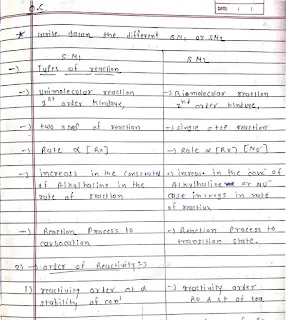SN1 and SN2 Reaction Notes PDF Download
Download this PDF to study SN1 and SN2 reactions in detail. Includes notes on the mechanisms, factors affecting the reactions, and a comparison of the two.
Keywords: SN1 Reaction, SN2 Reaction, Nucleophilic Substitution, Reaction Mechanism, Stereochemistry, Carbocations, Kinetics, Leaving Group, Nucleophile, Solvent Effects, PDF Download, Organic Chemistry Notes.
Understanding SN1 and SN2 Reactions: A Comprehensive Guide
SN1 (Substitution Nucleophilic Unimolecular) and SN2 (Substitution Nucleophilic Bimolecular) reactions are fundamental concepts in organic chemistry that describe two distinct mechanisms for nucleophilic substitution. These reactions involve the replacement of a leaving group on a carbon atom by a nucleophile, an electron-rich species. Understanding the differences between SN1 and SN2 reactions is crucial for predicting the outcome of reactions and designing effective synthetic strategies.
SN1 Reaction: A Two-Step Process
The SN1 reaction proceeds in two distinct steps:
- Formation of a Carbocation: The first step involves the heterolytic cleavage of the bond between the carbon atom and the leaving group, resulting in the formation of a carbocation intermediate. This step is unimolecular, meaning the rate depends only on the concentration of the substrate (the molecule containing the leaving group). The rate law for SN1 is therefore: Rate = k[Substrate]. The stability of the carbocation is crucial. More substituted carbocations (tertiary > secondary > primary) are more stable due to the electron-donating effect of alkyl groups (hyperconjugation) and are thus more likely to form.
- Nucleophilic Attack: The second step involves the attack of the carbocation by the nucleophile. Since the carbocation is planar, the nucleophile can attack from either side, leading to a racemic mixture if the carbon is a stereocenter. This step is fast and does not influence the overall rate of the reaction.
Factors Favoring SN1 Reactions
- Tertiary Alkyl Halides: These substrates form more stable carbocations.
- Weak Nucleophiles: Since the nucleophile attacks in the second step, a strong nucleophile is not required.
- Polar Protic Solvents: These solvents stabilize the carbocation intermediate and promote ionization. Examples include water, alcohols, and carboxylic acids.
- Good Leaving Groups: Halides like iodide (I-) and bromide (Br-) are good leaving groups.
SN2 Reaction: A Concerted One-Step Process
The SN2 reaction occurs in a single, concerted step. The nucleophile attacks the carbon atom from the backside, simultaneously with the departure of the leaving group. This results in inversion of configuration at the stereocenter (Walden inversion). Because both the substrate and the nucleophile are involved in the rate-determining step, the reaction is bimolecular. The rate law for SN2 is: Rate = k[Substrate][Nucleophile].
Factors Favoring SN2 Reactions
- Primary Alkyl Halides: These substrates are less sterically hindered, allowing the nucleophile to approach easily.
- Strong Nucleophiles: A strong nucleophile is required to effectively attack the substrate. Examples include hydroxide (OH-), alkoxides (RO-), and cyanide (CN-).
- Polar Aprotic Solvents: These solvents enhance the nucleophilicity of the nucleophile by not solvating it strongly. Examples include acetone, DMSO, and DMF.
- Good Leaving Groups: Similar to SN1, good leaving groups facilitate the SN2 reaction.
Key Differences Between SN1 and SN2 Reactions
Here’s a table summarizing the key differences between SN1 and SN2 reactions:
| Feature | SN1 Reaction | SN2 Reaction |
|---|---|---|
| Mechanism | Two-step (carbocation intermediate) | One-step (concerted) |
| Kinetics | First-order (Rate = k[Substrate]) | Second-order (Rate = k[Substrate][Nucleophile]) |
| Stereochemistry | Racemization (loss of stereochemical information) | Inversion of configuration (Walden inversion) |
| Substrate Preference | Tertiary > Secondary > Primary | Primary > Secondary > Tertiary |
| Nucleophile Strength | Weak nucleophiles | Strong nucleophiles |
| Solvent Preference | Polar protic solvents | Polar aprotic solvents |
| Carbocation Rearrangements | Possible | Not possible |
Applications and Examples
Understanding SN1 and SN2 mechanisms is crucial for predicting reaction outcomes and designing efficient syntheses. For instance, when trying to substitute a leaving group on a secondary carbon, the reaction conditions (solvent, nucleophile strength) can be adjusted to favor either SN1 or SN2. The choice depends on whether stereochemical control or a specific product distribution is desired.
By mastering the nuances of SN1 and SN2 reactions, you’ll be well-equipped to tackle more complex organic reactions and problem-solving scenarios.
Info!
If you are the copyright owner of this document and want to report it, please visit the copyright infringement notice page to submit a report.

